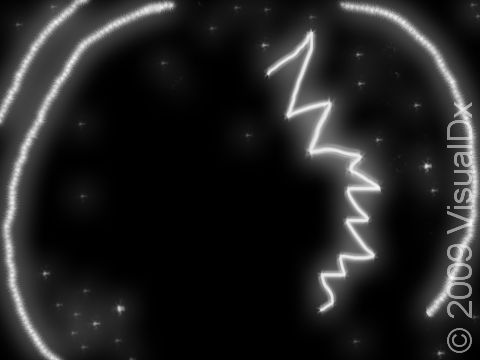Flashes and Floaters
Flashes and floaters are two common conditions that occur in the eyes.
Flashes, like the name implies, appear as flashes of light in your field of vision. They may look like lightning bolts, shooting stars, sparks, or an arc of light to the side. Flashes occur when the vitreous (a jelly-like substance that fills the middle of the eye) tugs on the retina or bumps against it, causing the sparks and shooting stars phenomenon. Flashes may occur with migraine headaches.
Floaters look like little lines, specks, branching twigs, or spiders in your field of vision. They are caused by tiny groups of cells in the vitreous. Floaters are easiest to see when looking at a blue sky or at a blank wall. With age, vitreous thickens and shrinks, causing more and sometimes larger floaters.
Although both conditions are common and typically harmless, flashes and floaters may both have more serious causes and consequences, such as if the floaters are from blood, inflammatory or infectious causes within the eye, torn retinal tissue, or when they are associated with a retinal detachment.
Who's At Risk?
Flashes and floaters are quite common, most often occurring in people aged 40 years and older. People who are more likely to experience it are those who:
- Are nearsighted (ie, you need glasses to see far away).
- Have had cataract surgery.
- Have had YAG laser surgery of the eye.
- Have had inflammatory disease causing swelling inside the eye.
- Have had previous injury to the eye (such as being hit by a fist or a ball).
Signs & Symptoms
Although you cannot see floaters or flashes just by looking at the eye, you know you have them when you see:
- Sparks of light.
- Shooting stars of light.
- Lightening-like bolts of light.
- Arcs of light to the side.
- Hair-like, spider-like, or twig-like objects in your line of vision.
Floaters are best seen when looking at a blue sky, a slightly off-white-colored wall, or the area lit up by car headlights in a dense fog. Floaters follow your line of vision as you look around, so if you look to the left, the floaters will drift into your left field of vision. Floaters are not the same as debris on the outermost layer of the eye (the tear film layer) that disappears once you rinse your eyes or blink several times.
Flashes seen with migraines are normally not associated with floaters. Migraine headaches produce flashes that are very distinctive, usually last for a set amount of time (approximately 20 minutes), and occur the same way each time. You can get migraine types of flashes without any headache (called ophthalmic migraine).
Self-Care Guidelines
There is nothing you can do to prevent the normal aging process that results in flashes and floaters. However, it is important to be aware of when flashes and/or floaters may be very serious and require medical attention (see When to Seek Medical Care). It is also important to remember to wear protective eyewear when working in conditions that could lead to an injury to the eye (eg, grinding, sawing, sports) as such an injury may cause the serious types of flashes and floaters.
Treatments
If the flashes and floaters are purely from normal aging, then no treatment is needed. If there is a retinal tear, bleeding, retinal detachment, or infection inside the eye, medical and surgical therapy will be needed. Such therapy may include:
- Laser surgery.
- Surgical repair of a retinal detachment.
- Injection of drugs into the eye.
- Topical eye drops.
- Oral medications.
While floaters can be removed by doing a vitrectomy (a surgical procedure to remove some vitreous from the eye), it is rarely done because the risks of surgery outweigh the benefits.
Visit Urgency
What is most critical about flashes and floaters is their timing and course. If you have the sudden onset of flashes and floaters and/or a noticeable increase in the number of flashes and floaters, it may be a sign of a more serious problem, such as a retinal tear or retinal detachment. Having such a sudden onset or increased number of flashes and floaters requires prompt attention and evaluation by an eye care professional. If you have experienced a recent injury to the eye and then notice flashes and/or floaters, you should go for a medical evaluation. Other reasons to seek medical attention for flashes and/or floaters are:
- Vision loss.
- Pain in one or both eyes.
- A curtain or veil that blocks part of your vision and does not move or float.
- If you think you have had a posterior vitreous detachment, which involves seeing large or ring-like floaters.
Trusted Links
References
Boyd K. What are floaters and flashes?. American Academy of Ophthalmology. https://www.aao.org/eye-health/diseases/what-are-floaters-flashes. 2023 Dec 5.
Charles S. Vitreous. In: Riordan-Eva P, Augsburger JJ, eds. Vaughan & Asbury’s General Ophthalmology. 19th ed. New York, NY: McGraw-Hill; 2017.
Horton JC. Disorders of the eye. In: Loscalzo J, Fauci AS, Kasper DL, Hauser SL, Longo DL, Jameson JL, eds. Harrison’s Principles of Internal Medicine. 21st ed. McGraw Hill; 2022.
Last modified on January 29th, 2024 at 1:47 pm

Not sure what to look for?
Try our new Rash and Skin Condition Finder

